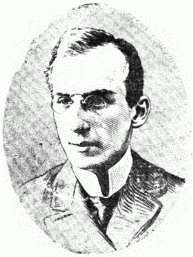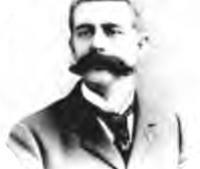
A “New” Napier Game (by John S. Hilbert)
William Ewart Napier was born in England on January 17, 1881. His family soon moved to the United States, and because they did American chess has been all the richer. Napier first played correspondence chess, participating in one of the Continental Correspondence Chess Association’s preliminary sections in 1894. When his family moved to Brooklyn, Napier, then only thirteen, looked up the one man in the city who could do more for him, in terms of chess, than any other: the twenty-four-year-old Hermann Helms.
Napier and Helms have long been associated with the Brooklyn Chess Club. It was there that Napier earned the moniker “Brooklyn’s Boy Wonder” for his imaginative play. At fifteen Napier crushed nineteen-year-old Frank Marshall in an 1896 match (7-1, with 3 draws), became the club’s 1897 champion, and from there went on to win brilliancy prizes over the likes of Mikhail Chigorin (Monte Carlo 1902), Curt von Bardeleben (Hanover 1902) and John Barry (Cambridge Springs 1904)
But the Brooklyn Chess Club was not where Helms and Napier first played chess. Odd as it may sound today, Napier was at first believed too young by some members to join a men’s club, even though in early 1895 he was fourteen. While Napier visited the Brooklyn Chess Club to play against the likes of Showalter in simultaneous exhibitions, Helms first took him for regular play to the Brooklyn Young Men’s Christian Association’s Chess and Checker Club. Founded in 1888—one of the co-founders was the then-nineteen-year-old Helms himself—the Brooklyn YMCA’s Chess and Checker Club was housed in a small room on the third floor of the Brooklyn YMCA building on Fulton Street. A major difference between this club and others in the city was that the YMCA club actually taught its members chess. Literally chalk and blackboards were used, as well as lectures by experienced chess players. Members were divided into classes, and played handicap tournaments. Hermann Helms was club Secretary. His brother Charles played there as well. It was here that the young “chess fiends,” as they were called, came first to hone their skills. (New York World, December 20, 1892)
The following game is one of a half dozen or so of Napier’s earliest published efforts. It is distinctive for two reasons. First, it is the only example so far found of his play at the Brooklyn YMCA’s Chess and Checker Club. Second, it does not appear among the over 300 Napier games in my Napier: The Forgotten Grandmaster (Caissa Editions 1997). Although not great chess, it does illustrate something of the young “chess fiend’s” early days.
Helms introduced his Eagle readers to the game the morning after it was played, rather than waiting to give it in his weekly Brooklyn Eagle column. At the time the book was researched, I had access only to the weekly Eagle columns held in scrapbooks at the White Collection in Cleveland. I am pleased the game can now be added to Napier’s canon. Helms wrote that the game was “a good specimen of the strong play of W.E. Napier, the youthful chess genius belonging to the Young Men's Christian Association Chess and Checker Club,” adding that it was “contested in the handicap tourney of that club last night.”
John S. Hilbert © 2013
GAME SOURCE: Brooklyn Daily Eagle, March 30, 1895, p.4, col.2
For more Chess History, visit www.rookhouse.com





